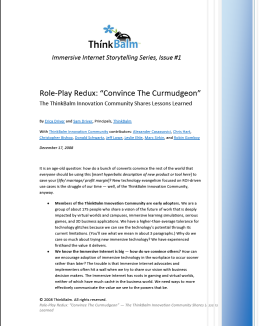As analysts covering work-related use of immersive technologies, we have long wrestled with terminology to describe the trends we are tracking and put some bounds around an emerging software market. We aren’t the only ones; naming conventions continue to be a popular topic of discussion at meetings and conferences (see the Sept. 28, 2009 ThinkBalm blog article, “To cross the chasm, we must close the language gap.”) The question always seems to come back to, “Do we call it virtual worlds?”
Our answer has consistently been no. We use the term Immersive Internet to describe the big picture. 3D virtual worlds are, of course, an important part of the Immersive Internet—but they are not the whole picture. A glaring example is the adoption of pseudo-3D virtual event platforms from companies like InXpo, ON24, and Unisfair. Enterprises are utilizing virtual event platforms for marketing events, trade shows, training sessions, and more—all use cases that are also targeted by providers of 3D immersive software.
The name game is a red herring
The more important issue is, “What do the trends in adoption of immersive technology mean?” Our recent research findings shed light on our position to include both 3D and pseudo-3D in our coverage of enterprise immersive software:
- Look where the money is. In our January 19, 2010 ThinkBalm report, The Enterprise Immersive Software Decision-Making Guide, we sized the enterprise immersive software market at $50M USD in 2009. A substantial portion of this number revenue was from pseudo-3D virtual events.
- Production deployments tell a story. All together, the virtual event platform vendors hosted several thousand virtual events in 2009—InXpo alone delivered more than 1,000 500 and ON24 delivered more than 300. We don’t see any evidence of the pseudo-3D virtual events market slowing down.
- Customers are lumping it all together. The customers who buy immersive technology are placing little distinction between 3D and pseudo-3D (depending on the use case, of course). They want to solve their business problem; they don’t care about the nitty gritty of how it gets done. Many times we have talked with decision makers who are looking at both 3D and pseudo-3D solutions for bringing a few hundred people together for a virtual off-site event.
Pseudo-3D faces fewer barriers to adoption than 3D
When pseudo-3D wins out over a 3D virtual world (e.g., Second Life or ReactionGrid), 3D collaboration environment (e.g., ProtonMedia or Teleplace), or 3D immersive learning environment (e.g., ARI PowerU or SAIC’s Forterra OLIVE), it’s often because the barriers to adoption were lower (see table). (We covered barriers to adoption, and springboards for overcoming them, in depth in the September 23, 2009, ThinkBalm report, Crossing the Chasm, One Implementation at a Time.)
| Barriers to adoption of 3D immersive technology | Effect these barriers have on pseudo-3D immersive technology adoption |
Technology pre-requisites:
|
Pseudo-3D technology runs in a Web browser, with no plugin required. High-end graphics cards and computer processors are not needed.Computer headsets are not necessary (though may be desirable) because users are typically not speaking to each other via voice. Audio from presentations can utilize built-in computer speakers. |
| Technology pre-requisite: high-bandwidth Internet connection | While rich 3D graphics are not being rendered in pseudo-3D environments, video streams are common and can be bandwidth hogs in locations where multiple people are watching video from separate computers simultaneously. |
| Firewall prevents users from being able to interact with others or the environment. | Because the software runs in a Web browser, the needed firewall port is already open. |
The user experience:
|
The user experience is familiar to anyone who’s used a browser and attended a web conference. People are accustomed to using keyboards and mice to interact with the Web. |
Our take: pseudo-3D is on the rise
- Market forces support an inclusive definition of immersive technology. Some immersive environments are virtual worlds, but an increasing number are not. They are 3D or pseudo-3D collaboration tools, learning environments, or event platforms. We anticipate that over time, the lines between 3D and pseudo-3D will blur. 3D technologies are constantly pushing the limits of scalability and vendors are starting to include measurement tools, while pseudo-3D vendors are going after training use cases and always-on, persistent environments.
- Mainstream adoption will follow the path of least resistance. Tremendous power is built into 3D environments, especially when they are combined with communication and collaboration tools. But technology adoption has to be simple for the end user. A “DIY” toolbox or a super-rich 3D environment may not be the path of least resistance. If pseudo-3D continues to outpace 3D in ease of adoption, this is where the customers will go.
- The technology has to be browser-based—or as easy to use and manage as a browser. Our research has illuminated a number of barriers to adoption of 3D environments that could be circumvented with a simpler, more familiar user interface and streamlined deployment options. Browser technology minimizes installation issues, firewall port issues, and a number of other practical problems. On top of that, browser-based immersive technology fits in with the way people are already working; business applications are increasingly web-based, as are collaboration tools and office productivity software.
